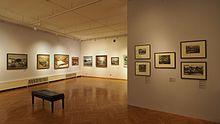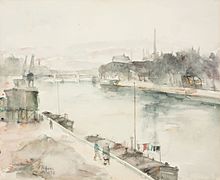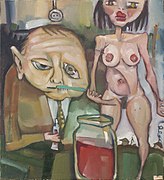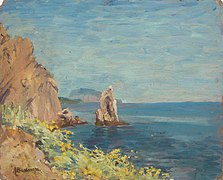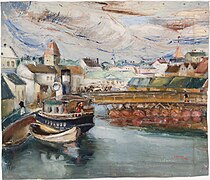Tartu Art Museum
The Tartu Art Museum is a state art museum in Tartu , Estonia .
History of the museum
In 1940 each member of the “Pallas” art association donated at least one work to the museum. From February 26 to March 10, 1940, over 124 works were exhibited on the premises of the Kunstverein. The Art Museum was founded in 1940 by the Tartu City Council on November 17, 1940. The location was Suurturg 3 in Tartu. During the Second World War , the museum's collection was moved to other buildings and other places of refuge. After the war, a new house was built at 14 Vallikraavi Street, which opened on May 2, 1946. The museum's collections and workshops have been at this location ever since.
In 1988 the art museum at Raekoja plats 18 got another building, which had previously been renovated by Polish restorers. It's a slender, classicist building from 1793, sloping like the Leaning Tower of Pisa . The inclination of the house resulted from the fact that one side was built on the remains of the city wall and the other side on wooden stakes. The house belonged to the Barclay de Tolly family and also served as a pharmacy. This building has been used as an exhibition building since the renovation and transfer to the museum. Concerts, lectures and other events also take place on the three floors of the building.
The collection includes works by Estonian and foreign artists associated with Estonia and includes around 23,000 works of art dating from the 18th century to the present day. The museum's exhibitions are designed based on its own collection, expanded to include works from Estonian and foreign museums and galleries. In recent years there have been a number of exhibitions that have sparked a broad discourse. The most controversial exhibition was MÖH? FUI! ÖÄK! OSSA! VAU! in 2012, which showed the most controversial works of Estonian art since the 1990s. Another exhibition that received national attention was My Poland in 2015 . On Recalling and Forgetting , modern Polish art about the Holocaust .
From 2013 to 2017 Rael Artel was director of the museum. She previously worked as a freelance gallery owner and curator. Signe Kivi has been director since 2017 .
collection
The collection started with 133 works by the artists of the Pallas artist group . It draws on the legacy of the artist group. The exhibits include works by Nikolai Triik , Konrad Mägi , Ado Vabbe and others.
The collection also includes works by important Russian artists such as Iwan Konstantinowitsch Aiwasowski , Iwan Iwanowitsch Schischkin , Maximilian Alexandrowitsch Woloschin , Konstantin Andrejewitsch Somow , Mikhail Fjodorowitsch Larionow , Natalija Sergejewna Goncharova and others.
Selected works
Self-portrait Andrus Johani 1933
Karl Pärsimägi Farmhouse with a Stove 1935
Natalija Goncharova Construction with Flowers 1916
Konrad Mägi Landscape by Vilsandi 1913-1914
Karl Pärsimägi Toomemäe motive 1936
Nikolai Triik portrait by V. Martna 1910
Peeter Allik Ain Protsini pruut 1990
Lilly Walther Vaade Jalta ja Gursuffi vahel 1918
Kaarel Liimand Tartu motif 1935
Individual evidence
- ↑ a b c Tartu Kunstimuuseum: Ajalugu. In: tartmus.ee. Retrieved May 1, 2018 .
- ^ Leaning House in Tartu, Estonia . In: Visitestonia.com . ( visitestonia.com ).
- ↑ MÖH? FUI! ÖÄK! OSSA! VAU! Eesti kaasaegse kunsti klassika - Tartmus . In: Tartmus . ( tartmus.ee ).
- ↑ «Möh? Fui! Öäk! Ossa! Vau! »: Karuteene moodsale kunstile . In: Kultuur . ( postimees.ee ).
- ^ My Poland. On Recalling and Forgetting - Tartmus . In: Tartmus . ( tartmus.ee ).
- ↑ a b c Tartu Kunstimuuseumi direktorina jätkab Rael Artel | Ministry of Culture. In: kul.ee. Retrieved May 1, 2018 (Estonian).
- ↑ Ajalugu - Tartmus . In: Tartmus . ( tartmus.ee ).
- ↑ Tartu Kunstimuuseumi direktoriks saab Signe Kivi | Ministry of Culture. In: kul.ee. Retrieved May 1, 2018 (Estonian).
Web links
Coordinates: 58 ° 22 ′ 50.8 " N , 26 ° 43 ′ 27.1" E

